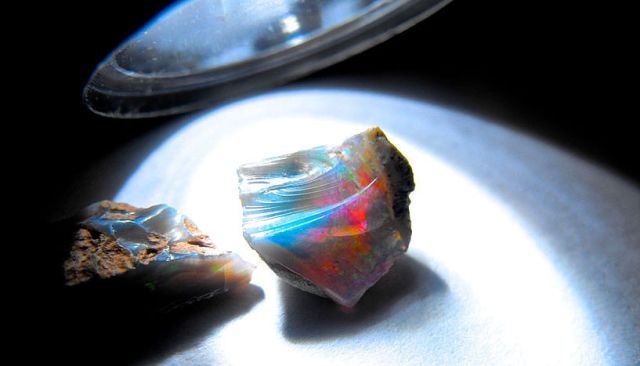Jun 1 2016
There is a wide range of applications of crystals in various fields like physics, engineering, gemology or metallurgy.
 An ideal example how light interacts with the small structures of colloidal particles - the Opal (Copyright- Yagan Kiely/flickr.com/http://bit.ly/20QhT1D).
An ideal example how light interacts with the small structures of colloidal particles - the Opal (Copyright- Yagan Kiely/flickr.com/http://bit.ly/20QhT1D).
A research group comprising of Christos Likos and Lorenzo Rovigatti from the Faculty of Physics of the University of Vienna, in association with the National Institute of Standards and Technology (NIST, USA) and Princeton University (USA) have formed a novel technique to arrange large, periodic crystals. Their findings have been reported in the ACS Nano journal.
Crystals are solids made up of microscopic building blocks organized in a systematic pattern. They have infinite applications right from jewelry, to metallurgy, to electronics. The use of crystal is based on its intricate pattern of their constituents’ arrangement and these constituents are quite sensitive to the interaction between the building blocks.
The inter particle forces remain fixed in atomic and molecular crystals, and the only method to change the microscopic arrangement is by changing the particles, or by varying the external conditions. However, in soft matter Physics , where the building blocks are much larger and much more complex than atoms, it is possible to design and engineer building blocks with extremely tunable properties
Subsequently, research has been conducted to synthesize colloids that assemble themselves to form highly symmetric patterns with technologically pertinent characteristics. For example, photonic crystals, which are specific crystal lattices that display interesting optical properties, allow a few bands of wavelengths of light to be transmitted through their interior whilst blocking other wavelengths.
Opal is an example of a natural photonic crystal whose attractive color is attributed to the way light interacts with the colloidal particles’ microscopic structure arranged in a regular lattice. the charm of opal lies on its multicolored iridescence, which is attributed to the presence of crystallites. Crystallites are tiny crystals that are arbitrarily oriented with respect to each other.
Additionally, colloidal crystals assembly is often confused with polymorphism.
Different structures are characterised by comparable thermodynamic stabilities, making it difficult to produce a single morphology at will.
Christos Likos, Faculty of Physics, University of Vienna
The absence of long-range order is unfavorable for various applications. Methodologies to improve the growth of long-ranged, monocrystalline samples in experiments need to be designed. Researchers have been focusing on developing methods to improve the growth of monocrystalline, large structures. Computer simulations can be used to assemble technologically relevant, non-polymorphic crystals.
The system crystallizes into a mixture of difference micocrystals. However, the competing structures assembled by the colloids have different geometries and different internal void distributions. This difference can be exploited by tuning the size of polymer additive to interact uniquely with the void symmetry of the desired crystal, effectively stabilizing it against the competitor.
Lorenzo Rovigatti, University of Vienna
The findings of the research group not only shows an alternative to current approaches which, mostly produces disappointing results, but also guides towards experimental understanding of highly-ordered colloidal open crystals in the future.